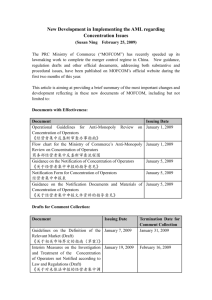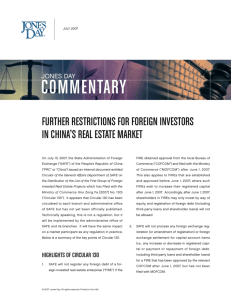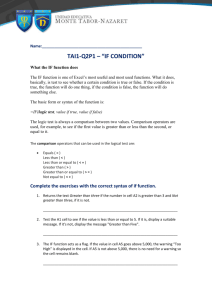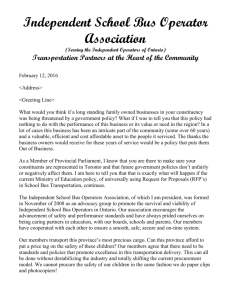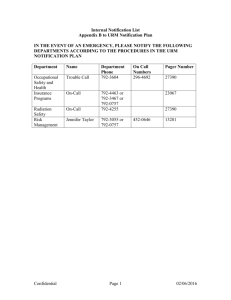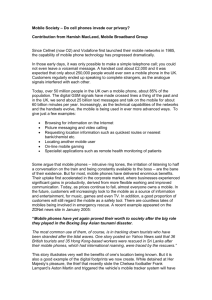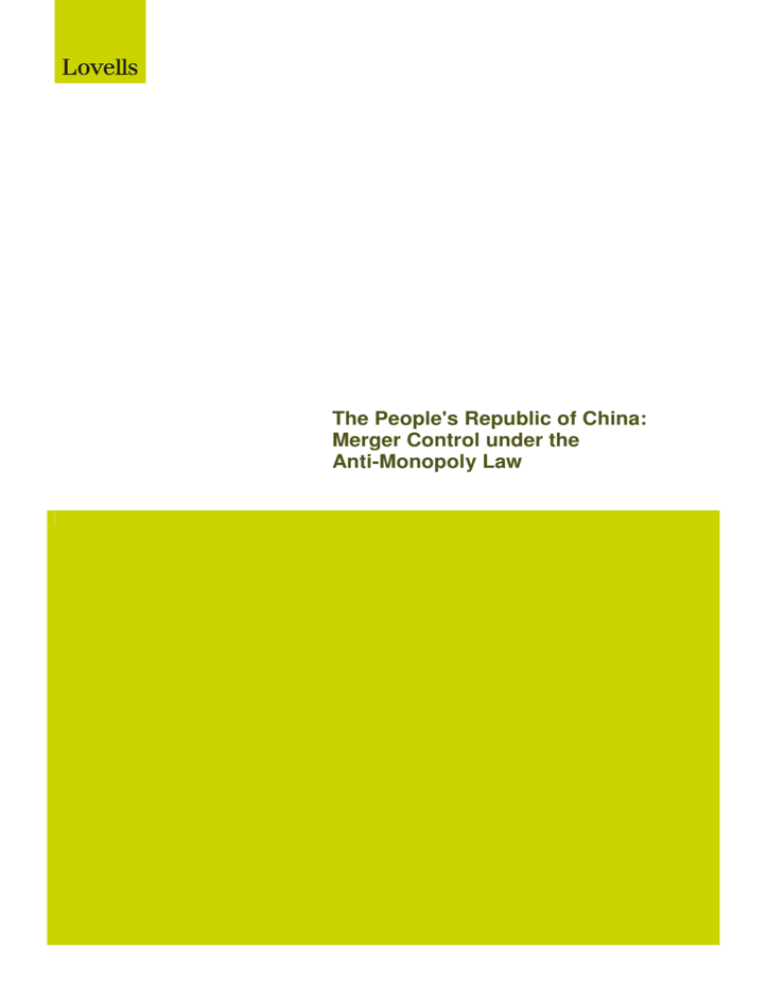
The People's Republic of China:
Merger Control under the
Anti-Monopoly Law
Further information
If you would like further information on any aspect of
our competition law practice in China please contact
a person mentioned below or the person with whom
you usually deal.
Contact
Shanghai
Andrew McGinty
T +86 21 6138 1688
andrew.mcginty@lovells.com
Kirstie Nicholson
T +86 21 6138 1688
kirstie.nicholson@lovells.com
June 2009
This note is written as a general guide only. It
should not be relied upon as a substitute for specific
legal advice.
Contents
1
OVERVIEW
1
2
NOTIFIABLE CONCENTRATIONS
2
3
PROCEDURE
4
4
PENALTIES
5
5
OVERVIEW OF FURTHER GUIDANCE AVAILABLE
5
6
MERGER CASES
5
7
COMMENTS
7
8
AML-RELATED DOCUMENTS
8
Lovells
Lovells Competition
1
The People's Republic of China: Merger Control Under the AML
1.
OVERVIEW
•
The People’s Republic of China AntiMonopoly Law (the "AML"), which came
into effect on 1 August 2008, requires
that transactions which qualify as
“concentrations” and which reach
certain defined thresholds must be
notified to the Anti-Monopoly Law
Enforcement Agency (the "AMEA").
The AML itself does not define the
relevant thresholds, which are
contained in the Implementing
Regulations on the Notification of
Concentrations of Business Operators
(the "Implementing Regulations on
Concentrations") adopted by the State
Council of the People's Republic of
China on 3 August 2008. Whilst the
Implementing Regulations on
Concentrations provide very little further
guidance on the interpretation of these
thresholds, MOFCOM has recently
published some further guidance
relating to the AML merger control
regime. The full list of further guidance
is set out in Annex 1.
On 18 November 2008, the Ministry of
Commerce ("MOFCOM") (the AMEA
body responsible for merger control
clearances under the AML) published
its first conditional approval decision
under the AML relating to the proposed
acquisition by InBev of Anheuser Busch
(the "InBev Case"). On 18 March
2009, MOFCOM published its first
prohibition decision under the AML,
which related to the proposed
acquisition by Coca-Cola Corporation of
Huiyuan Juice (the "Coca-Cola Case").
On 23 April 2009, MOFCOM published
its second conditional approval
decision, which related to the
acquisition of Lucite International Group
Limited by Mitsubishi Rayon Co., Ltd.
(the "Mitsubishi Case").
Practical implications of the notification
requirements under the AML include:
Mandatory notification and
suspension: notifiable transactions
must be notified to the AMEA and
cannot be implemented prior to
MOFCOM clearance, which may
be express or tacit once the
statutory deadlines for clearance
have passed.
•
Pre-notification: where the
concentration must be notified, the
Business Operators concerned are
recommended to file an advance
draft notification with the AMEA for
discussion (in practice, this is likely
always to be required).
•
Derogation from the obligation
to notify: there is no express
provision for any general
derogation from the obligation to
notify a concentration falling within
the thresholds. However, the AML
provides for certain specific
circumstances which will not be
considered a notifiable
concentration (see Notifiable
Concentrations below).
•
Waiting periods: the AMEA has
30 days from the date on which the
notification is declared complete to
conduct a preliminary examination
of the concentration, make a
decision on whether to conduct a
further examination and notify such
decision to the relevant Business
Operators. If the AMEA decides to
conduct a further examination, it
has an additional 90 days in which
to take a final decision, although in
certain circumstances the AMEA
may extend this period by up to a
total of a further 60 days. Whilst
this is not clear in the AML,
MOFCOM has informally indicated
that the periods refer to “working
days”; although in its published
decisions so far, MOFCOM has
appeared to apply calendar days. If
the AMEA fails to make a decision
before the expiry of the relevant
time limit, the transaction is
deemed cleared and the Business
Operators are permitted to
implement the concentration.
•
Notification documents: Business
Operators need to start assembling
the required documents and
information at an early stage.
Failure to provide complete
information may delay the start of
the formal merger clearance
process while MOFCOM requests
further information.
•
Substantive appraisal: a
concentration’s compatibility with
the AML is appraised according to
whether or not it will, or may have,
the effect of eliminating or
restricting competition.
•
Conditions: the AMEA may
impose conditions on a nonprohibited concentration of
Business Operators in order to
reduce the harmful impact of such
concentration on competition in the
relevant market(s). As set out in
further detail below, MOFCOM has
already adopted two conditional
approval decisions (namely, in the
InBev and Mitsubishi Cases).
•
Sanctions: where prior clearance
is not obtained for a transaction,
the AMEA may order the
termination of implementation of
the concentration, the disposal of
the shares or assets involved in the
concentration, the transfer of the
business and/or impose fines of up
to RMB 500,000.
•
Allocation of resources: Business
Operators involved in a transaction
need to ensure that adequate time
Lovells Competition
and resources are allocated to
consideration of the applicability of
the notification requirements of the
AML, the collection of documents
and other required information, and
also to dealing with any follow-up
action required under the relevant
procedures. Our experience tells
us that the amount of time and
effort needed is frequently
underestimated by the Business
Operators in question.
•
2.
Joint-ventures: whether the
establishment of a joint venture
may constitute a notifiable
concentration is not addressed by
either the AML or the Implementing
Regulations on Concentrations.
However, in March 2009, in the
Revised Draft Provisional
Measures Relating to the
Notification of Concentrations of
Business Operators ("Revised
Draft Notification of
Concentrations Guidance")
issued by MOFCOM for the second
round of public consultation, it is
indicated that the establishment of
a full-function joint venture by two
or more Business Operators which
reaches the notification thresholds
does constitute a notifiable
concentration.
NOTIFIABLE CONCENTRATIONS
2.1 Concentration
The AML and the Implementing
Regulations on Concentrations indicate
that the following will be considered a
“concentration”:
•
a merger between Business
Operators;
•
the acquisition of control over
another Business Operator by
means of equity or asset purchase;
2
•
the acquisition of controlling rights
or decisive influence over another
Business Operator by means of
contract or any other means.
The Revised Draft Notification of
Concentrations Guidance provides
further guidance on the concept of
"obtaining control over other Business
Operators", as follows:
(i)
"acquiring 50% or more of the
shares carrying voting rights or
assets of another business
operator; and
(ii) despite not acquiring 50% or more
of the shares carrying voting rights
or assets of another business
operator, obtaining the ability to
decide on the appointment of one
or more members of the board of
directors and the appointment of
the core management personnel,
the financial budget, sales and
operations, pricing, major
investments and other important
management and operational
decisions and so forth in relation to
such other business operator by
means of acquiring shares or
assets, as well as by contractual or
other such means. All of the aforementioned factors must be taken
into account when determining
whether or not a party obtains
control over other business
operators. However, the veto rights
granted to medium and small
shareholders for the purpose of
protecting the interests and rights of
such shareholders with regard to
matters including amending the
Articles of Association, capital
increase and decrease and
liquidation shall not be deemed to
confer control".
Paragraph (ii) above is of particular
application to the situation of a minority
shareholder. It appears that, in such
circumstances, in determining the
existence of control, MOFCOM will take
account of all the above-mentioned
factors, none of which is decisive. It is
not, however, clear whether the
existence of any single one of the listed
factors will be sufficient to confer joint
control on a minority shareholder.
The AML also provides for certain
circumstances in respect of which a
concentration will not be notifiable,
namely:
•
where one of the Business
Operators owns 50% or more of
the voting shares/assets of each of
the other Business Operators
involved in the concentration; and
•
where 50% of more of the voting
shares/assets of each Business
Operator involved in the
concentration are owned by
another Business Operator not
involved in the concentration.
In summary, therefore, the AML merger
control provisions will not apply to intragroup re-organisations.
Significantly, the Revised Draft
Notification of Concentrations Guidance
also introduces into Chinese merger
control, for the first time, the concept of
"full-function" joint ventures and
confirms that these will be considered a
"concentration". It provides that "where
two or more business operators
("Parent Companies") jointly establish
a new independent entity which
operates on a continuous basis, the
newly established enterprise will be
regarded as a concentration of business
operators as referred to in Article 20 of
the AML, except for any special
purpose entity which merely serves
certain functions such as research and
development, sales or manufacturing
certain products for the Parent
Lovells Competition
Companies". The proposed definition
of a "full function" joint venture is,
therefore, similar to that used by the EC
Commission pursuant to the EC Merger
Regulation. It is not clear whether all
full function joint ventures that meet the
thresholds will be notifiable, or whether
there is also a requirement of "joint
control" by the parents. Although the
Revised Draft Notification of
Concentrations Guidance is not yet final
and has not yet became effective, its
provisions do send a clear signal that
the merger control provisions of the
AML are intended to cover the
establishment of a full function joint
venture (indeed, the application of the
AML merger control provisions to joint
ventures has been confirmed informally
on a number of occasions in comments
made by various MOFCOM officials). It
is unclear at the time of writing when
the final version of the Revised Draft
Notification of Concentrations Guidance
will become available.
2.2 Notification Thresholds
A concentration will only be notifiable
where the relevant thresholds are
satisfied.
3
financial year is in excess of RMB 2
billion, and there are at least two
Business Operators each of whom
have turnover in China for the
preceding financial year in excess
of RMB 400 million.
In cases falling outside these
thresholds, the AMEA may still
investigate where the facts and
evidence show that the concentration
has, or may have, the effect of
eliminating or restricting competition.
This wide residual power has raised
some concerns, in particular about
giving MOFCOM the right to selectively
pursue investigations into transactions
based on non-competition law
concerns. However, earlier this year,
MOFCOM published for public
consultation further draft guidance on
the procedures for the investigation of
concentrations of business operators
which do not reach the notification
thresholds, but which are suspected of
having, or of being likely to have, the
effect of excluding or restricting
competition. We are not aware of any
cases where MOFCOM has exercised
this power to date.
2.3 Calculation of turnover
The jurisdictional thresholds for the
notification of concentrations are set out
in the Implementing Regulations on
Concentrations, as follows:
•
•
the aggregate global turnover of all
Business Operators to the
concentration for the preceding
financial year is in excess of RMB
10 billion, and there are at least
two Business Operators each of
whom have turnover in China for
the preceding financial year in
excess of RMB 400 million;
the aggregate turnover in China of
all Business Operators to the
concentration for the preceding
The Implementing Regulations on
Concentrations contain virtually no
guidance on the calculation of turnover
for the purpose of the thresholds.
However, the Revised Draft Notification
of Concentrations Guidance does
contain further guidance on the
calculation of turnover for the purposes
of the application of the jurisdictional
thresholds. In summary, "turnover"
includes the income of the relevant
Business Operators derived from the
sales of products and the provision of
services for the preceding financial
year, after deducting all kinds of taxes
and penalties; enterprise income tax
and value added tax cannot be
deducted from such income.
Significantly, it has now also been
confirmed that, where the concentration
of Business Operators includes the
acquisition of part of one or more
Business Operators, as far as the seller
is concerned, only the turnover relating
to the part involved in the concentration
will be relevant.
Generally, with the exception of the
seller, as described above, it will be the
turnover of the whole group to which the
parties belong that will be relevant for
determining whether the merger control
thresholds have been reached. In
particular, the turnover of any individual
Business Operator involved in the
concentration shall include the
aggregate of the turnover of each of the
following:
(a) the individual Business Operator in
question;
(b) other Business Operators directly
or indirectly controlled by the
Business Operator referred to in
item (a) above;
(c) other Business Operators directly
or indirectly controlling the
Business Operator referred to in
item (a) above;
(d) other Business Operators directly
or indirectly controlled by the
Business Operators referred to in
item (c) above;
(e) other Business Operators jointly
controlled by two or more of the
Business Operators referred to in
items (a) to (d) above.
The turnover of any individual Business
Operator involved in the concentration
does not include any turnover derived
from activities between the Business
Lovells Competition
Operators referred to in items (a) to (e)
above.
4
3.
PROCEDURE
3.1 Notification
Accordingly, based on the above, in
respect of a joint venture company, the
turnover of all controlling shareholders
will also be relevant.
When notifying a concentration to the
AMEA, a Business Operator must
submit the following documents:
Further, where there are other Business
Operators jointly controlled by any of
the individual Business Operators
involved in the concentration, special
provisions apply in order to prevent
"double-counting" of turnover, namely:
•
(i)
•
The aggregate turnover of all
Business Operators involved in the
concentration shall not include any
turnover derived from activities
between any jointly controlled
Business Operator and any other
Business Operator involved in the
concentration which controls such
jointly controlled Business
Operator, or any turnover derived
from activities between Business
Operators which control any such
jointly controlled Business
Operator;
(ii) The aggregate turnover of all
Business Operators involved in the
concentration shall include turnover
that is derived from activities
between any jointly controlled
Business Operator and third
parties, and shall be equally divided
between the Business Operators
involved in the concentration which
control any jointly controlled
Business Operator.
the notification form, containing the
names of the Business Operators
involved in the concentration, their
addresses, business scopes and
the date on which the concentration
is to be implemented;
an explanation of the effects of the
concentration on the relevant
market(s);
•
the underlying agreements relating
to the concentration;
•
the audited financial and
accounting reports for the previous
fiscal year of the Business
Operators involved in the
concentration; and
•
other documents and materials
required by the AMEA.
The applicant should prepare the
notification materials in accordance with
the Guidance Opinion on the
Documents and Materials required for
Concentration Notifications, together
with the Notification Form (the
"Documentary Guidance Opinion")
which contains further information about
the documents and materials that must
be submitted, and also the Notification
Form which may be completed for the
notification.
3.2 AMEA examination
Once the set of notification documents
has been declared complete by the
AMEA, the AMEA has 30 days in which
to conduct its preliminary examination
of the concentration and an additional
90 days within which to carry out further
investigations. If the AMEA decides to
conduct a further examination, it may
extend the timetable by up to a further
60 days.
If the AMEA fails to make a decision
within the above time limits, the
concentration is deemed cleared and
the Business Operators may implement
the concentration.
When examining the concentration, the
AMEA will take into account the
following factors:
the relevant market share(s) of the
Business Operators in, and any ability
to exercise power over, the relevant
market(s);
•
the degree of concentration within
the relevant market(s);
•
the impact of the concentration on
market access and technological
advancement;
•
the impact of the concentration on
consumers and other relevant
Business Operators;
•
the impact of the concentration on
national economic development;
•
any other factors that may affect
competition on the relevant
market(s).
If a foreign investor participates in a
concentration that involves
considerations of national security (e.g.
involves a strategic or sensitive sector
or products with a military application),
the AMEA may conduct a further,
separate, examination on the basis of
such national security. The process for
this examination is opaque.
Lovells Competition
3.3 Decisions of the AMEA
The AMEA may decide to approve the
notified concentration. It can also
authorise the concentration but impose
restrictive conditions on it in order to
reduce any harmful impact on
competition. Where the notified
concentration is likely to have the effect
of excluding or restricting competition,
the AMEA must issue a ruling to prohibit
such concentration. However, the
AMEA is entitled to rule against
prohibiting a concentration which is
potentially harmful to competition if the
Business Operator is able to prove
either that:
•
•
the beneficial impacts on
competition resulting from the
concentration clearly outweigh the
harmful impacts; or
the concentration complies with the
public interest requirements.
Accordingly, if the Business Operator
can prove one of the above mentioned
conditions (no details are available
about the type or standard of proof that
must be submitted), the AMEA may, in
its discretion, decide not to prohibit the
concentration.
4.
PENALTIES
If a concentration is implemented
contrary to the AML or prior to the
AMEA’s decision, the AMEA may:
•
order the termination of the
implementation of the
concentration;
•
order the disposal of relevant
shares/assets;
•
order the transfer of the relevant
business;
5
•
order any other measures
necessary to restore the status quo
prior to the concentration;
•
impose a fine of up to RMB
500,000.
5.
OVERVIEW OF FURTHER
GUIDANCE AVAILABLE
On 7 January 2009, MOFCOM
published various documents containing
further practical guidance on the
notification of concentrations, namely:
•
Guidelines for Anti-Monopoly
Investigations into Concentrations
of Business Operators
•
Flow chart for Anti-Monopoly
Investigations into Concentrations
of Business Operators
•
Guidance Opinion on
Concentration Notifications
•
Guidance Opinion on the
Documents and Materials required
for Concentration Notifications,
together with the Notification Form
MOFCOM followed the above guidance
with the publication of a number of
additional draft documents for public
consultation. This included guidance on
some of the key outstanding issues
relating to the AML merger control
process, such as market definition, the
review of transactions not meeting the
turnover thresholds, the calculation of
turnover, application of the merger filing
provisions to joint ventures and the
rights of the parties to defend
themselves.
6.
MERGER CASES
MOFCOM has so far published only
three decisions relating to AML merger
control. Details of these are set out
below, as they provide some further
guidance on the practical application of
the AML merger control regime by
MOFCOM.
It should be noted that MOFCOM is
only obliged to publish its prohibition
and conditional clearance decisions (i.e.
not its unconditional clearance
decisions).
6.1 InBev case
This case relates to the proposed global
acquisition of Anheuser Busch by
InBev. This was MOFCOM's first
published decision under the AML
merger filing provisions. It was also the
first case in which MOFCOM imposed
conditions on a transaction. After
carrying out its examination, MOFCOM
found that the InBev Case would not
have the effect of excluding or
restricting competition on the market for
beer in China and, therefore, issued a
clearance decision. This is the only
indication that we have about
MOFCOM's findings in relation to the
relevant market in this case;
interestingly, MOFCOM seems to have
accepted both a wide product market
(including all beer) and a wide
geographic market (including the whole
of China).
However, despite finding that the
proposed transaction would not
adversely affect competition in the
relevant market, MOFCOM somewhat
surprisingly nonetheless imposed
restrictive conditions on the parties
relating to future acquisitions of
additional shares in certain Chinese
beer companies by the merged
Lovells Competition
company, in order to reduce any future
negative impact on competition.
The decision is very short and contains
no details about MOFCOM’s
investigation, analysis or reasoning.
Generally, it is somewhat disappointing
that MOFCOM did not take the
opportunity to publish more details
about its review process and the factors
that led it to impose conditions on the
parties to the transaction, and how it
arrived at the choice of conditions it
finally imposed.
6.2 Coca-Cola/Huiyuan case
The second, and certainly the most
controversial case so far, relates to
Coca-Cola's proposed acquisition of
Huiyuan Juice.
Coca-Cola had announced its intention
to acquire Huiyuan, a Hong Kong listed,
China-based producer of fruit juices in
September 2008. The proposed
transaction was controversial from the
start, sparking criticism in China about
the sale of one of the country’s bestknown brands to “foreigners” and
numerous reports of intense lobbying of
MOFCOM by third party Chinese juice
manufacturers opposed to the bid.
The proposed transaction was subject
to merger review under the AML and
was duly notified to MOFCOM. After an
in-depth investigation, MOFCOM finally
adopted and published its decision
prohibiting the proposed transaction.
In common with its InBev decision,
MOFCOM’s Coca-Cola decision is
relatively short and lacking in detail
about MOFCOM's investigation and
analytical processes, as well as the
underlying reasoning for its decision;
much of the text simply describes the
procedural process. (By way of
comparison, the last prohibition decision
6
adopted by the EC Commission was in
2007 relating to the Ryanair/Aer Lingus
case (Case No COMP/M.4439), and
was over 500 pages long!) The
decision does include a brief summary
of MOFCOM’s key concerns, including
the risk that, following the transaction,
Coca-Cola might abuse its dominant
position in the carbonated drinks
industry by imposing bundled sales of
juice drinks on retailers/distributors, or
by imposing other restrictive trading
conditions on third parties, which would
restrict competition in the market for
juice drinks. Interestingly, the decision
also confirms that MOFCOM entered
into negotiations with Coca-Cola in
respect of possible remedies to deal
with the competition concerns raised;
ultimately the conditions offered were
considered insufficient to satisfy
MOFCOM’s concerns (no details of the
proposed conditions have been made
public).
Although the decision indicates that
competition-based reasons led to the
prohibition decision, the lack of detail
and reasoning have led to suspicions
that non-competition-related, political
and policy-based reasons also played a
role. There are also question marks
about the logic behind such reasoning
as is provided: for example, any future
abuse of a dominant position by CocaCola could have been dealt with under
the existing law by the initiation of an
investigation by the AMEA under
Chapter 3 of the AML (i.e. the
prohibition on the abuse of a dominant
position), and the imposition of
appropriate penalties.
In response to criticism about the lack
of detail in its decision, on 24 March
2009, a MOFCOM spokesperson
provided further details about the
decision in the Coca-Cola case in an
official interview with the media (the
"Interview") (a report of the Interview
was published by MOFCOM the
following day). The Interview provided
some interesting further information, in
particular, MOFCOM clarified that the
relevant product markets involved in the
Coca-Cola Case included two separate,
but related, markets within the market
for non-alcoholic beverages, namely:
fruit juice drinks and carbonated drinks.
This is the first time that MOFCOM has
provided details of its analysis of the
definition of the relevant market in an
AML merger review case.
Both Coca-Cola and Huiyuan have
subsequently announced that they
respect MOFCOM's decision, and so
any appeal now seems unlikely.
6.3 Mitsubishi Case
On 23 April 2009, MOFCOM issued a
decision clearing the Mitsubishi Case
subject to a number of substantive
conditions intended to remedy
competition concerns MOFCOM had
identified in relation to certain relevant
chemicals markets in China.
After examining the proposed
transaction, MOFCOM concluded that it
would result in an adverse impact on
competition on the market for MMA. In
particular, the market share of the
merged company would be 64% in
China, which would enable it to exclude
and/or restrict competition in the
Chinese MMA market. Furthermore,
since Mitsubishi is active in both the
MMA market and two downstream
markets, MOFCOM concluded that after
completion of the proposed transaction
the merged company would also be
capable of vertically foreclosing
competition on downstream markets
through its dominant market position in
the upstream market for MMA.
In order to lessen the potential adverse
impact of the proposed transaction,
Lovells Competition
MOFCOM entered into negotiations
with the parties to determine whether
steps could be taken to address the
competition concerns identified.
The conditions imposed on the parties
in this case are more sophisticated than
those imposed in the InBev Case and
are as follows:
(a) Capacity divestment: Lucite must
divest upfront 50% of its annual
MMA production capacity to one or
more unaffiliated third party
purchasers for a period of five
years. If the divestment is not
completed within the time limit,
MOFCOM will appoint an
independent trustee to sell off
Lucite China's entire stake to an
independent third party. The
divestment must be completed
within six months from the date of
closing of the Proposed
Transaction, a period which may be
extended by MOFCOM for another
six months at the request of Lucite
China.
(b) Independent operation of Lucite
China until completion of
capacity divestment: Lucite China
and the MMA business of
Mitsubishi in China must be
operated separately, with an
independent management team
and board membership during the
period from the closing of the
Proposed Transaction to the
completion of the capacity
divestment. During the independent
operation period, both parties shall
continue to sell MMA in competition
with each other in China. All
exchanges of pricing, customer or
other commercially sensitive
information during this period will
be prohibited and will be punishable
by the imposition of fines.
7
(c) No further acquisitions or new
plants in China within next five
years: Without the prior approval of
MOFCOM, for a period of five years
from the closing of the proposed
transaction, the merged company
must not acquire or build any
manufacturer of MMA monomer,
PMMA polymer or cast sheet in
China.
This is the first MOFCOM decision
requiring parties to divest any
production capacity as a condition of
approval under the AML. The structure
of the conditions is, however, somewhat
ambiguous; in particular, how is it
possible to divest capacity for only 5
years? Does this mean that what is
envisaged is actually closer to a
licensing, or leasing, or outsourcing
arrangement? No reasons as to why a
temporary divestment was chosen are
provided in the decision.
The willingness by MOFCOM in this
case to adopt relatively complex and
flexible undertakings to remedy
competition concerns can be
considered an indication that MOFCOM
is already becoming more sophisticated
in its decisions. In particular, the
imposition of a temporary (five year)
divestment is interesting in that it falls
short of an outright divestment of assets
whilst, at the same time, the structure of
the conditions also provides MOFCOM
with the fall-back solution of an outright
divestment should the temporary
divestment not be completed as agreed.
However, the publication of the relevant
deadlines is somewhat unfortunate for
the parties to the transaction: it clearly
puts the parties at a commercial
disadvantage in the negotiation of the
divestment of part of the capacity to a
potential third party purchaser, because
as the deadline comes closer, it may
become something of a "fire sale".
In terms of procedure, MOFCOM
officially accepted the notification
approximately only one month after the
initial submission: this is a relatively
short pre-notification period, particularly
in a case that raised competition
concerns. Further, the decision
indicates that MOFCOM initiated its indepth review on 20 February 2009,
following the expiry of the preliminary
review period. This timing is interesting
as, in common with its other published
AML decisions, it appears that
MOFCOM used calendar (rather than
working) days for the calculation of the
relevant deadline. MOFCOM also
completed its in-depth review on 20
May 2009, well within the statutory
deadline, thus confirming that
MOFCOM can, and will, issue an early
decision where appropriate. This
relatively speedy procedure by
MOFCOM may be considered good
news for parties to a transaction subject
to a tight commercial timetable.
7.
COMMENTS
The AML has only been in force since
August 2008, and it would be unrealistic
to expect all aspects of its application to
be clear in such a relatively short space
of time; this period represents only the
first few steps of what is likely to be a
long march in the development of a
comprehensive competition law in
China. It is therefore, not surprising that
many questions remain about the
practical implementation of AML merger
control. What is clear is that the merger
control regime in China cannot be
ignored by multinationals.
The further guidance recently published
by MOFCOM is very much welcomed,
as this provides business operators with
greater certainty. The publication of
some of the guidance in draft for public
consultation is also a positive
development, as it gives investors an
Lovells Competition
opportunity to comment on and
(hopefully) change the trajectory of
potentially onerous or problematic
provisions.
As for MOFCOM's recent merger
control decisions, these send a
somewhat mixed message to potential
foreign investors in China, particularly at
a time when foreign investment in China
is actually declining. What is clear is
that international companies looking to
acquire Chinese companies, or
international companies with sales into
or a presence in, the Chinese market
will need to consider the potential
application of the AML merger control
provisions at an early stage of their
transaction and, where necessary, enter
into a dialogue with MOFCOM as soon
as practical to ensure that the merger
notification process progresses as
rapidly and efficiently as possible. It will
also be important to gauge the political
and policy waters in relation to any
potential acquisition, as it now appears
that despite spirited denials by
MOFCOM, this is an issue (as it is
overtly also in other international
jurisdictions) that foreign investors
ignore at their peril, particularly when a
foreign investor is seeking to make an
acquisition of a famous brand or in a
sensitive industry in China.
8.
AML-RELATED DOCUMENTS
We have prepared an English
translation of all the AML-related
documents mentioned in this Note,
which can be provided on request.
The original Chinese version of the
documents published by MOFCOM can
be found on MOFCOM's website at
http://fldj.mofcom.gov.cn/zcfb/zcfb.html.
The original Chinese version of the AML
and the Implementing Regulations of
Concentrations can be found on
8
MOFCOM's website at
http://fldj.mofcom.gov.cn/c/c.html.
Lovells Competition
9
ANNEX 1
List of further guidance published by MOFCOM
Further guidance
Guidelines for anti-monopoly investigations into concentrations of Business Operators (7 January 2009)
Contains further practical details relating to the notification process for concentrations that meet any of the relevant
jurisdictional thresholds and which must therefore be notified to MOFCOM.
Flow chart for anti-monopoly investigations of concentrations of Business Operators (7 January 2009)
Summarises in diagram form the procedures as set out in the above Guidelines for Anti-Monopoly Investigations into
Concentrations of Business Operators.
Guidelines for the notification of concentrations of Business Operators (7 January 2009)
Contains further guidance on the filing process, including confirmation of the filing party(ies). Namely, for mergers, all parties
involved in the merger must be named as filing parties, and for other types of concentration, only the business operator
obtaining control over another business operator (including through the ability to exercise decisive influence) will be the filing
party (although other parties must cooperate in relating to the filing).
Guidance opinion on the documents and materials required to be submitted with the notification form for the
notification of a concentration of business operators (7 January 2009)
Contains further information about the documents and materials that must be submitted when notifying a concentration to
MOFCOM. The provisions of this guidance are, in general, similar to those of the Anti-Monopoly Notification Guidelines for
Mergers and Acquisitions of Enterprises in China by Foreign Investors published by MOFCOM in 2007 (the "2007 Notification
Guidelines"). Whilst there are no express provisions in the AML dealing with the relationship between the previous and new
merger filing obligations, the filing obligations under the AML will take precedence on the basis of the Chinese principle of
interpretation that "the old replaces the new" for normative guidance issued at the same hierarchical level (notably, the previous
filing obligations applied only to foreign companies, whilst the AML merger requirements apply both to foreign and domestic
companies). This AML guidance does, however, contain some additional provisions not mentioned in the 2007 Notification
Guidelines, for example:
(i)
details of some of the factors that the applicant may use when determining the relevant market;
(ii)
confirmation that the applicant may incorporate into its notification relevant third party views;
(iii)
importantly, for the first time, MOFCOM has published a designated form for concentration notifications. Notifications
pursuant to the AML may be prepared in accordance with the requirements set out in the Notification Form, which covers
most of the required documents and other information, and is similar to the Form CO that must be submitted in respect of
merger filings pursuant to the EC Merger Regulation.
Draft guidance on the definition of the relevant market (7 January 2009)
Contains further guidance on the definition of the relevant market. The approach taken in the draft is broadly in line with the
approach adopted by the EC Commission. In particular, it proposes the use of the "hypothetical monopolistic test"; similar to
the EC "SSNIP" test.
Lovells Competition
10
Further guidance
Draft provisional measures relating to the investigation of concentrations that have not been notified in accordance
with law (19 January 2009)
Sets out the procedures that MOFCOM will follow in respect of concentrations that meet the thresholds for notification, but
which have not been notified to MOFCOM by the parties. In particular, it confirms the sources of information available to
MOFCOM and the penalties that may be imposed. The proposed process also includes an opportunity for the parties to submit
their comments on the notifiability of the concentration.
Revised draft provisional measures relating to the investigation of concentrations that have not been notified in
accordance with law (13 March 2009)
Makes extensive language changes to the previous draft. In particular, this draft adds several provisions specifying the
procedural rules by which AMEA officials must abide by during the investigation, and it clarifies how MOFCOM will dispose of
the concerned transactions, a point on which the previous draft was unclear.
Draft provisional measures on the collection of evidence relating to suspected concentrations that do not meet the
notification thresholds (19 January 2009)
Relates to the residual power of MOFCOM to review any concentrations that have, or may have, the effect of excluding or
restricting competition, even if the turnover thresholds are not met.
Revised draft provisional measures on the collection of evidence relating to suspected concentrations that do not
meet the notification thresholds (13 March 2009)
Largely adopts the language in the previous draft. In particular, this draft sets out that, besides MOFCOM, the business
operators being investigated, and other entities and individuals must also keep in confidence trade secrets and other
confidential information they learn during the investigation, unless the disclosure of the information is required by law, or prior
consent of the right-holders of the trade secrets has been obtained.
Draft provisional measures on the investigation and treatment of suspected concentrations that do not meet the
notification thresholds (6 February 2009)
Sets out further guidance on the procedures that MOFCOM will follow in the investigation and treatment of any concentration
that does not meet the notification thresholds, but which has, or may have, the effect of excluding or restricting competition (in
circumstances where the turnover thresholds are not met). Importantly, this guidance also clarifies the rights of the Business
Operators to the concentration to defend themselves where MOFCOM decides to exercise its residual power to investigate.
Lovells Competition
11
Further guidance
Draft provisional measures on the notification of concentrations of Business Operators (20 January 2009)
This document is significant as not only does it represent the first time that MOFCOM has specified the circumstances in which
"control" will be deemed to arise, but it also confirms that the establishment of a "green field" joint venture by two or more
Business Operators which reaches the notification thresholds constitutes a concentration subject to merger control review. The
document also contains helpful further guidance in respect of the calculation of turnover, which was one of the key outstanding
issues in relation to the application of the turnover thresholds.
Revised draft provisional measures on the notification of concentrations of Business Operators ("Draft Notification of
Concentrations Measures") (13 March 2009)
Article 3 contains further details about the circumstances in which a minority shareholder may be considered to have "control".
Namely, "despite not acquiring 50% or more of the shares carrying voting rights or assets of another business operator,
obtaining the ability to decide on the appointment of one or more members of the board of directors and the appointment of the
core management personnel, the financial budget, sales and operations, pricing, major investments and other important
management and operational decisions and so forth in relation to such other business operator by means of acquiring shares
or assets, as well as by contractual or other such means. All of the afore-mentioned factors must be taken into account when
determining whether or not a party obtains control over other business operators. However, the veto rights granted to medium
and small shareholders for the purpose of protecting the interests and rights of such shareholders with regard to matters
including amending the Articles of Association, capital increase and decrease and liquidation shall not be deemed as obtaining
control". It is currently unclear whether the minority shareholder must be able to decide on all of the above-mentioned issues
in order to be considered to have control, or whether any one of them will be sufficient.
Article 3 also contains further details about the situations in which a joint venture will be considered a concentration and
therefore potentially notifiable. In summary, MOFCOM has adopted the EC Commission's full functionality test. Namely,
"where two or more business operators ("Parent Companies") jointly establish a new independent entity performing on a lasting
basis, the newly established enterprise will be regarded as a concentration of business operators as referred to in Article 20 of
the AML, except for any special purpose entity which merely serves certain functions such as research and development, sales
or manufacturing certain products for the Parent Companies".
Draft provisional measures on the investigation of concentrations of Business Operators (20 January 2009)
Sets out the procedures that MOFCOM will follow in respect of the investigation of concentrations. It includes a provision that
MOFCOM may, as required, organise a hearing and seek opinions from experts, government authorities, industry associations,
customers, and so forth. Importantly, further details are also provided about the restrictive conditions that the parties may
propose and/or MOFCOM can impose, to eliminate the anti-competitive effects of a concentration.
Revised draft provisional measures on the investigation of concentrations of business operators (13 March 2009)
Articles 12 and 13 contain further guidance on the procedures relating to the proposal by the parties of remedies to eliminate
competition concerns arising out of the proposed concentration. In particular, it confirms that both MOFCOM and the business
operators involved in the concentration are entitled to give opinions and suggestions on modifying the restrictive conditions in
order to eliminate or reduce the effects of excluding or restricting competition that the concentration of business operators has,
or is likely to have.
www.lovells.com
Lovells LLP and its affiliated businesses have offices in:
Alicante
Madrid
Amsterdam
Milan
Beijing
Moscow
Brussels
Munich
Budapest*
New York
Chicago
Paris
Dubai
Prague
Dusseldorf
Rome
Frankfurt
Shanghai
Hamburg
Singapore
Hanoi
Tokyo
Ho Chi Minh City
Warsaw
Hong Kong
Zagreb*
London
Lovells is an international legal practice comprising Lovells LLP and its affiliated businesses. Registered with the Ministry of Justice of the People's Republic of China as
a Foreign Law Firm Representative Office. Certificate No. 2-0002 (2003). Not licensed to practise Chinese law. Lovells LLP is a limited liability partnership registered in
England and Wales with registered number OC323639. Registered office and principal place of business: Atlantic House, Holborn Viaduct, London EC1A 2FG.
The word "partner" is used to refer to a member of Lovells LLP, or an employee or consultant with equivalent standing and qualifications. New York State Notice:
Attorney Advertising
Member of the Sino Global Legal Alliance with member offices in: Beijing Chengdu Chongqing Guangzhou Hangzhou Hong Kong Qingdao Shanghai Shenyang
Shenzhen Tianjin Wuhan and of the Pacific Rim Advisory Council with member offices in: Argentina Australia Brazil Canada Chile China Colombia France India
Indonesia Japan Korea Malaysia Mexico Netherlands New Zealand Peru Philippines Singapore Taiwan Thailand USA Venezuela
© Copyright Lovells LLP 2009. All rights reserved. HKGLIB#805288
*Associated offices

